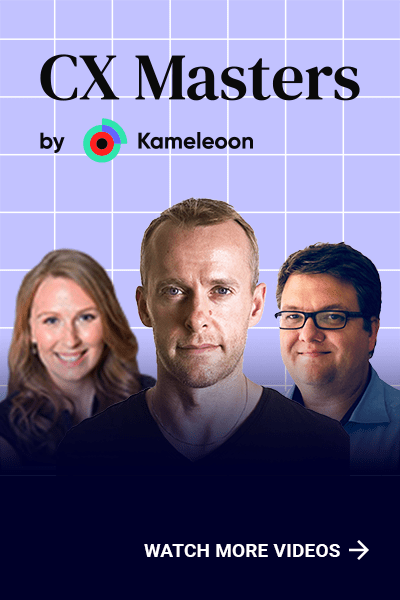
Learn the 3 CX drivers that power growth
Every company wants to grow. But all too often, the way they try to achieve that growth is flawed.
Without good data, some teams are left debating—sometimes even arguing—over the best changes to make. Others attempt massive, transformational projects to achieve growth. Neither approach is ideal.
The founder and CEO of GO Group Digital and konversionsKRAFT, and noted speaker, André Morys, knows that companies need to think about growth differently. He believes the three factors in his Agile Growth Model™—agility, customer centricity, and experimentation—are the right tools to drive growth for businesses today.
See more CX Masters videos
Outdated practices no longer generate enough growth
Many executives have learned to trust their instincts when making decisions. That is because they have deep expertise in their field. And teams of experts should make good business decisions by pooling their gut feelings together, right? Maybe.
Other times, teams will push through major projects, tying up the company’s best talent and capital, hoping that the project will deliver the growth they want in one fell swoop. Will they? Again, maybe.
Gut feelings don’t leverage data, and major projects are too slow
The problem in relying on either opinion or major projects for growth is the same: neither approach properly utilizes customer data. Aggregate gut feelings may point a business in the right direction generally, but they don’t offer clear insights as data and experimentation can.
Projects can transform your business, but in the end, you might have changed so many things that you can’t tell what worked and what didn’t. They start from the top and often aim to achieve executives’ goals, rather than from the customers’ problem. As a consequence, they bog down organizations with things that don’t necessarily matter.
Generate growth by practicing agility, championing your customer and using experimentation as a way to make data-driven decisions
Instead of these outmoded approaches, André Morys suggests businesses follow the Agile Growth Model™. Data drives this process, and it helps us better understand our customers' needs, fears, and motivations so we can make rapid, meaningful changes to our products.
The Agile Growth Model™ identifies three key drivers of growth:
- Agility
- Customer-centricity
- Experimentation
Driver #1: Agility
Morys reveals that instead of seeking growth through large, transformative projects, businesses should be more agile. Go smaller and faster by making more iterative changes. The purpose is to shorten the feedback loop length between when a team ships a new change and when they can validate its impact on the business.
Driver #2: Customer-centricity
Customer-centricity guides the changes you make to your product and leads to better, more reliable growth. A change in your product doesn’t “work” unless it addresses your customers' needs, fears, and motivations.
Driver #3: Experimentation
While agility and customer-centricity should guide your business, experimentation is the engine that drives your growth. It generates the data you need to make informed decisions about your next changes.
When experimenting, your team compares a change against a control version of your product. Then, you measure customer behavior in each version and compare the results. Experimentation takes the gut and the HIPPO out of the decision making process and replaces it with data.
You can take action right now on all 3 drivers
The single greatest benefit of the Agile Growth Model™ is that you can apply it right away.
Agility: Increase the velocity of your tests
High-velocity testing means you run more experiments and learn faster. In other words, you’re able to collect more data than your competitors, putting your organization at an advantage in serving customers.
For example, did tweaking the search algorithm send more customers to product pages? No? Then move on and try a different tweak right away. Did shortening the copy on a landing page increase engagement? Yes? Then try shortening the copy on other landing pages right away and see what happens.
Customer-centricity: Use your user data for CX optimization
Practicing customer-centricity means taking the time to discover what are the pain points and goals of your platform’s users. Help them avoid pain and achieve their goals.
Practically, this means understanding customers’ problems before creating new features or elements. Projects should be aimed at solving specific problems, and experimentation allows organizations to test whether their solution is indeed correct.
For example, there is nothing personally-identifiable about the type of device a user uses to visit your site. Try serving them an optimized page and track their engagement. Nor is there anything identifiable about the source of customer acquisition. Test serving personalized experiences to customers who come to you through organic search, social media, or another source.
Experimentation: Create self-reinforcing insights
Experimentation drives the feedback loops you need to generate growth. Set up experiments whose results will teach you something valuable about what your customers want, no matter the results. The insights you gather from those experiments will also help establish a culture of experimentation, as teams get to see how their ideas really impact customer behavior in practice.
Watch growth take on a life of its own
It doesn’t take long for the habit of experimentation to take hold when you apply the Agile Growth Model™. With the right tools, experimentation is easy. You won’t be left guessing what your customers want. You won’t be stalled out trying to complete outdated, unwieldy projects. Instead, you’ll have brought your business closer to your customers and generated the growth your business needs.
Want to see how the top brands use experimentation to uncover their customers’ biggest problems?
Click here to learn how to leverage user data to perform customer experience optimization, including beginner methods like A/B and multivariate tests, to advanced methods like AI-based targeting.




